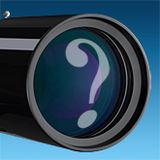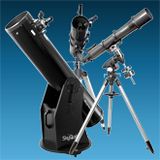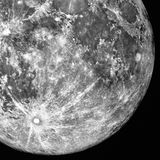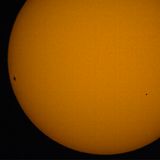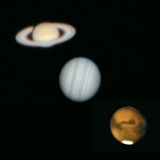
Getting a new telescope, especially for the first time, is a thrilling experience. A telescope or binoculars of any size will open the universe to you. Here then is a list of bright and easy objects to help you get acquainted (or perhaps re-acquainted) with your telescope.
Tip: Use Starry NightŪ to find and print out star charts for these objects.
Our Solar System

The Moon
Many exquisite details can be seen on the lunar surface with nothing more than the smallest of telescopes or binoculars. In fact, no other object in the solar system will show you more detail than the Moon.
Seasoned Moon watchers know that the best time to observe the Moon's features is when they are near the terminator (the line that separates the lit and unlit portions of the Moon). The interplay between light and shadow bring out a three-dimensional aspect to the craters and ridges that is lost once the area becomes fully lit.
The Moon is the ideal first target for a new telescope user — it is easy to find and the view will not disappoint.
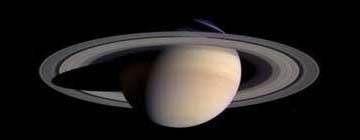
Saturn
It will blow you away — your mind that is. To earthbound eyes, Saturn is a bright orange star. Binoculars will accentuate Saturn's color and show its largest moon Titan, an 8th magnitude object.
But to see Saturn in all its glory you'll want to view it through a telescope. Share this moment with others; it's one of the greatest pleasures in amateur astronomy!
A magnification of at least 30X is required to see Saturn's rings clearly. The first thing you'll notice is how the ring system seems split into two. The void between rings A and B is named the Cassini Division and stands out as a dark dividing lane that is easily seen in small telescopes. Ring C, known as the Crepe ring, lies inside rings A and B and is more challenging to detect. Saturn's fainter outer rings cannot be seen with a small telescope.
You can find Saturn well positioned for viewing in the eastern sky at around 11 P.M. from mid-northern latitudes.
Within Our Milky Way Galaxy
Perseus Double Cluster
The night sky is full of jewels — in this case a pair of sparkling earrings. The Perseus Double Cluster (NGC 869 and 884) is made up of a pair of bright and large open clusters embedded in the faint glow of the Milky Way. The double cluster is visible without optical aid but binoculars are required to separate the two clusters, which are half a degree apart. A telescope gives the best view of the Double Cluster, with many stars of differing brightness visible. NGC 869 is more tightly packed than NGC 884. Both clusters are about 7000 light years away and are part of the Perseus arm, one of the spiral arms of our Milky Way. The two clusters are a few hundred light years apart.
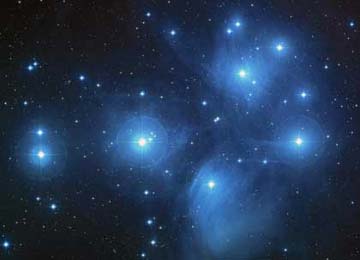
Pleiades Cluster (M45)
The Pleiades is the most famous of all open star clusters, containing around 500 members set against a black velvet sky. This young and bright open cluster is easily visible to the unaided eye and resembles a smaller version of the Big Dipper. At least 6 hot blue stars are readily visible and keen eyed observers can see more. Because of its large diameter, 2 degrees, M45 is best seen in binoculars (but a telescope will help you see the fainter members).
In some ancient cultures, ceremonies to honor the dead were held on the day when the Pleiades reached its highest point in the sky at midnight (this is around Halloween). Ancient Aztecs believed the Pleiades would be overhead at midnight the day the world ended.
Messier 41 (M41)
M41 is an open cluster about half a degree in diameter. 4 degrees to the north of M41 is Sirius, the brightest star in the sky. M41 is a naked eye cluster containing several bright stars, the brightest of which is a reddish star located near the center. The cluster is best seen under low power in telescopes. It was possibly noticed by Aristotle around 325 BC.
Orion Nebula (M42)
Easily visible to the naked eye as a fuzzy patch in the middle of Orion's sword (the ancients depicted the constellation of Orion as a Hunter). What we call the Orion Nebula is just the central part of a larger cloud that stretches across several hundred light years. Four bright stars in a parallelogram near the nebula's center form the Trapezium. These hot young stars heat up the surrounding gas clouds, causing the nebula to emit light.
Try to view the Great Orion Nebula on every possible occasion with any type of optical instrument as well as with the naked eye. The wealth of detail visible in this nebula is simply outstanding. Intricate wisps, shapes and the contrast between brighter and darker regions never ceases to amaze. A dark sky far away from city lights will help.
Outside Our Galaxy
Andromeda Galaxy (Messier 31)
The Andromeda Galaxy is one of the most magnificent objects in the night sky and undoubtedly the most famous galaxy outside our own Milky Way. Easily visible as a hazy patch to the naked eye, the galaxy covers as much of the sky as 5 full moons put together. Binoculars will show Andromeda in its entirety with a clear brightening towards the center. Binoculars will also show two of Andromeda's companion galaxies, M32 and M110. Careful observation of the nuclear region with a telescope will reveal faint dust lanes and other structures.
M31 was once thought to be a nebula inside our galaxy, but in 1923, astronomer Edwin Hubble showed that it lies outside the Milky Way. M31 is now thought to be about 2.9 million light years away. It is over 150 000 light years across, and has a mass 1.2 trillion times that of our Sun.
January 2006




